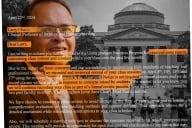You have /5 articles left.
Sign up for a free account or log in.
If the allegations are true, the University of Montana may indeed have a systemic problem with sexual assault on campus. But as the university awaits the results of a federal investigation into whether it failed to respond to numerous accusations of assaults on campus, the most publicized of which were made against football players, it’s already moved to require all students – male and female, athlete and otherwise – to complete an online video tutorial and score 100 percent on an accompanying quiz before they can register for second-semester classes.
The idea is troubling to some who suggest the university is forcing a new requirement on all students because of the criminal behavior of a minority. But Montana officials say every student has a personal responsibility to get educated as a contributing member of the campus community.
“One of the things that we wanted to do was be very proactive and to really create an environment where [a string of assaults on campus] cannot easily happen again,” said Danielle F. Wozniak, an associate professor of social work and co-chair of Montana’s University Council on Student Assault who recommended and helped develop the tutorial. “And so part of that was educating every single student about information that we felt was imperative to their safety.”
Personal Empowerment Through Self Awareness, or PETSA, is a 20-minute tutorial comprising eight short videos that cover topics like state law as it pertains to rape and sexual assault, cultural contributors to such crimes (including alcohol and gender stereotypes), bystander intervention, and what constitutes consent. Immediately after viewing, students take a seven-question quiz. (Some are multiple-choice, others true/false or fill-in-the-blank. For example: What is the definition of sexual assault? Or: If you see two drunk friends leaving a party together, what should you do?) The tutorial is run through Montana’s learning management system, Moodle, which allows the university to bar any student who doesn’t get every answer right from registering for second-semester classes. Students who fail can immediately retake the quiz until they’re successful.
Wozniak believes the university is the first to require this form of education, which also includes links to other campus resources and Department of Justice statistics, Student feedback has been “really, really, really positive,” Wozniak said. “Especially from women who have lived with this issue all their lives…. They are just all saying, ‘Thank you, thank you, thank you for bringing this out in the open, thank you for being able to talk about it, thank you for doing this.' ”
Given that classes only just began Monday. Zachary Brown, a university senior and president of the Associated Students of the University of Montana, said most students don’t yet know about the new tutorial. But Brown, who previewed the website before it went live, says it’s a good development and will be eye-opening for some students.
“I think it’ll make a lot of people question different sexual interactions they’ve had in their lives,” Brown said. “[The videos] are very provocative. I think they’re going to spur a lot of emotions and reactions from people, positive and negative, and I think they’ll make people uncomfortable in many situations, which ultimately is probably a good thing, from my perspective.”
But Peter Wood, president of the National Association of Scholars, which has criticized harassment training in other contexts, said the basis for the overbroad mandate was sketchy at best. Wood questioned some statistics cited in the videos -- including one stating that only 2 percent of people lie about being assaulted and another saying 82 percent of rapes are perpetrated via psychological, not violent, force -- and said the quiz requirement “really makes it an instrument of intimidation and psychological coercion more than it is a question of knowledge.” (Though Wood did concede there are “probably elements of both.”)
“The videos themselves – at least one of them – makes the point that sexual predators are a very small part of the population…. but then their procedure for trying to correct this is imposed universally on the entire student body with a rather severe sanction,” Wood said. “A university willing to take vigilant steps to create a campus environment where personal respect and sexual violence are rare is probably doing something right. But there’s also an effort under way here, I think, given the involvement of the Department of Justice and Department of Education investigating the University of Montana, to create a kind of public relations campaign of, ‘Look how vigilant we are in trying to improve ourselves.' ”
But Brown argued that if the university is going to change anything – and there are no cynical intentions – it has to take a comprehensive approach.
“Its approach is both aimed at potential perpetrators, but also at potential victims, too,” Brown said. “The focus of what we’re trying to tackle as an institution is really broadly cultural, and you can’t attack cultural problems by pinpointing certain people or groups. I mean, it has to be an everyone kind of approach.”
The Department of Justice announced in May it would examine whether the university and its police, as well as local law enforcement and prosecutors, handles sexual assault allegations appropriately. In part, it will investigate whether Montana violated Title IX of the Education Amendments of 1972 and Title IV of the Civil Rights Act of 1964, which prohibit sex discrimination and sexual assault and harassment in education programs. One complaint in particular, made against a football player at the university, is being examined in coordination with the Education Department’s Office for Civil Rights.
The tutorial won't necessarily work in Montana's favor when it comes to the Justice Department investigation, because the department is looking at whether the university did enough to prevent past assaults, not future ones, said Erin Buzuvis, a law professor at Western New England University and author of the Title IX Blog. But if the inquiry does find that Montana violated the law it will likely require the university to take proactive prevention measures, she added, and when it does, the department will factor in the tutorial.
But the tutorial should help Montana in any future civil lawsuits related to assaults because it is evidence that the university is not “deliberately indifferent” to sexual assault on its campus, said Nancy Hogshead-Makar, a law professor at Florida Coastal School of Law and senior director of advocacy for the Women’s Sports Foundation.
Hogshead-Makar praised Montana’s proactive approach – while noting that such an undertaking is only as effective as the information it conveys.
“It’s unrealistic to think that an 18-year-old is going to read a sexual harassment policy until something’s already happened,” she said. Referring to commonly noted statistics that one in four college women report having survived rape or attempted rape at some point since their 14th birthday, she added, “If we knew a quarter of women while they were in higher education were going to seriously damage their self-esteem, their outlook in life, their sense of the future – if we knew something like that was going to happen, we would do more than just provide counseling afterward. This is not just counseling afterward.”
While Justice noted when it launched the case that the university had at least 11 reports of sexual assault involving students in an 18-month period, with at least 80 reported rapes in Missoula in the past three years, the institution has seen particular anger and subsequent fallout over accusations against football players, which account for at least three cases. The National Collegiate Athletic Association is conducting its own investigation into those cases.
The complaint that prompted the Justice Department to enter the fray accused four football players of gang raping a student while she was intoxicated.
Montana vice president Jim Foley later inquired as to whether one student who spoke publicly about her case could be punished under the Student Code of Conduct, a public records request revealed. “Is it not a violation of the student code of conduct for the woman to be publicly talking about the process and providing details about the conclusion?” Foley asked the former dean of students. Foley also asked why university officials were referring to the alleged incident as a “gang rape.”
Former Montana quarterback Jordan Johnson was charged with rape last month after he had sex with a woman who resisted while they watched a movie in her room. The Grizzlies’ head football coach and athletic director were fired, apparently in connection to the accusations.
This past winter, after receiving two separate reports from women who said they were drugged and gang raped by several male students, the university hired former Montana Supreme Court justice Diane Barz to review cases of sexual assault on campus. Barz ultimately uncovered nine more cases, bringing the total to 11, and said the investigation should continue.
“The UM has a problem of sexual assault on and off campus and needs to take steps to address it to ensure the safety of all students as well as faculty, staff and guests,” Barz said when she announced her findings. “This is not a situation by any means restricted to our student athlete population.”
The tutorial is not the only new way in which Montana is addressing sexual assault since the investigations opened. University President Royce Engstrom also has held a series of public forums on the issue, and faculty and staff will get additional training, too. (They are also able, but not required, to take the online tutorial.) The university system has also approved new sexual assault policies that aim to ensure compliance with state law prohibiting sexual discrimination.
Buzuvis praised the tutorial.
"Everyone, women and men, athletes and non-athletes, can play a role in preventing and addressing assault and can benefit from being more informed on the subject," she said in an e-mail. "I think that the university is right to try a community-wide intervention in order to change the culture."








